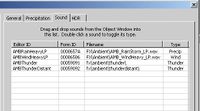General:Mark Lampert: "It's Quiet... Almost Too Quiet"
This is a developer diary for The Elder Scrolls IV: Oblivion. The original diary can be found here.
That's where I come in
Hello and welcome to my Team Diary for The Elder Scrolls IV: Oblivion! My name is Mark Lampert and I handle the many aspects of audio here at Bethesda Softworks. I joined the Oblivion team in the last days of March of 2005, but I've been a huge Elder Scrolls fan since having first stepped into the world of Tamriel in 1993 with the release of The Elder Scrolls: Arena. That's a long time to wait and I can't tell you how excited I am to be here now, working on this game with this team and helping bring to life the massive province of Cyrodiil and the dark netherworld known as Oblivion.
If you've played previous Elder Scrolls games, you know very well how rich and detailed the games' outside worlds are. Well, you've truly never seen anything like this. Right from the start I'm presented with a truly amazing landscape of lush forests, rolling highlands, snow capped mountains, lowland swamps, and grassy meadows ... all of which will need my attention in some way. Great sound design means immersion and I can tell right away that a visual masterpiece like this will require a sonic landscape that sucks you right in as powerfully as the visuals. And that's only one aspect – let's not forget clashing swords, the sound of clattering about in a full suit of plate armor, slamming shut city gates as you enter a new town to explore, wading through water along a riverbank, casting a blazing fireball, the crack of thunder in a heavy downpour, gentle chirping of crickets at night, and on and on.
With only a year to go until the completion of this truly massive and detailed game, I needed to hit the ground running immediately upon arriving for my first day of work: meeting the rest of the team, familiarizing myself with the game as it currently stood, talking with producers and getting an idea of what needed to be done, what was already done, and generally just where to start when faced with such a beast. Thankfully, our friends at sound design house d-Sonic had already gotten the ball rolling by filling out a few areas of the game's audio assets, so I took the reigns from there and started out on what was to become a long and amazing journey as part of the Oblivion team.
GIVE ME A LITTLE MORE LEVEL ON THE CICADAS[edit]
Creating the sonic landscape
Using the sounds created by the d-Sonic crew as a starting point, I first proceeded to make variations of those sounds. The crash of a sword smashing into your shield is excellent, but we'll need several if it's to sound believable rather than just being repetitive. So when you raise up your shield or two-handed weapon (or even just your fists in order to block with!), you'll get a good feel for the power and weight of the weapons that your enemy is so eager to cut you down with. Add in the sound of heavy armor clanking about as you and your opponent circle one another and wait for your next opportunity to strike. Now add in a few hot-blooded taunts from that opponent as he mocks you. The combat system in this game was already a blast, but now we're really getting somewhere! This is what I love about sound design ... helping to give what you see on the screen a real feeling of substance. But this is just the tip of the iceberg ...
The part of the game's audio that I'm most excited to tell you about is the aforementioned great outdoors (look for Noah Berry's team diary detailing this amazing aspect of the game world). The team has put together a truly stunning landscape, complete with day/night cycles and dynamic weather. Covering so much ground -- literally, in this case -- with full audio detail would require a systematic approach and this is where I really got a lot of help from our programmers and the Elder Scrolls Construction Set. Working with audio programmer Mathew Krohn, I laid out a short list of features that we'd need in the Construction Set where I could specify a set of sounds for a defined geographic region of the game, give them time restrictions as well as weather parameters (Example: I only want this type of bird to chirp in the early morning hours, but I also want it to cease during a rainstorm and I want this all to take place only in the Great Forest). Mat went to work and it wasn't long before the system was in place and working exactly as described. From there I needed to create all of the audio assets for the nature sounds and organize them into a schedule for each region – birds, insects, wind in the trees, etc. – and then all that was left to do was plug in all of the data and start to fine tune it. One piece at a time, Cyrodiil came to life. Those of you who downloaded our E3 demo videos have heard a rough early version of this system in the forest demo. With a natural landscape so diverse and distinct in its geography, I wanted its sound to match -- if you can easily recognize the dense woods of the Great Forest from the wind-torn, frozen cliffs of the Jerall Mountains, then you should also be able to close your eyes and easily hear the difference as well. I think we've really achieved that and I know you're going to love it.
Creeping down into the darker, opposing end of the spectrum, we have the many windy caves, abandoned fort ruins, old mines, ancient Ayleid cities, city sewers, and other dungeons of Cyrodiil. Here you will find no birdsongs, chirping crickets nor gentle breeze, but rather the deep rumbles of the earth, dank and dripping catacombs and howling wind channeled through dark passageways. This is the polar opposite of the world above and the most comforting sound you'll find here is the warm crackle of a torch clenched tightly in your hand to light the way as you explore. This emphasizes what I think is another strong point in the audio of the game – contrast. The creepy quiet, distant moans and rumbles are a claustrophobic experience compared to the feeling of space and fresh air upon emerging from the dungeon's entrance into a clear, sunny day. The game's innumerable subterranean spaces got their sound treatment by hand as opposed to a system-wide method. The advantage in doing so was the ability to better highlight certain rooms or corridors in terms of sound.
So with all of these sounds to create to complete the game's atmosphere, where does one start? If I've got the time and a certain idea in mind, I'll record a sound myself here in our studio to use as one ingredient in a sound or even as that sound itself. Part of the sound of walking in heavy armor was achieved by shaking a heavy canvas grocery bag full of assorted scrap metal and this was further combined with deep thuds to add a greater sense of weight. The result is played simultaneously with the game's footstep system so that you can clank and rattle along as you walk through town showing off your shiny and intricately detailed Dwarven armor. All of these sounds are combined, trimmed, layered with effects, compressed, and mixed down out of my multitrack software.
From there I take the resulting mixed down stereo file and further trim it up in my stereo or mono audio editing software, then spit it out into the individual variations (eight files in this particular case) that I want to hear play back when I'm walking with a full suit of heavy armor in the game.
Naturally, there are further steps before a sound is truly complete and most of those revolve around mixing or getting the relative volume levels in the game in good shape. I need a good reference point from which to mix, and the best references are going to be the loudest sounds in the game: exploding fireballs, the smash of a weapon against a solid object, and so on. Once I've got the loudest sounds at a good level, I can mix those other sounds relative to those which I'd like to be quieter. But most important of all is that the spoken dialog is loud and clear above anything. Wait a minute ... I haven't told you about all the voice in this game? Well, throw another log on the fire and get comfortable.




